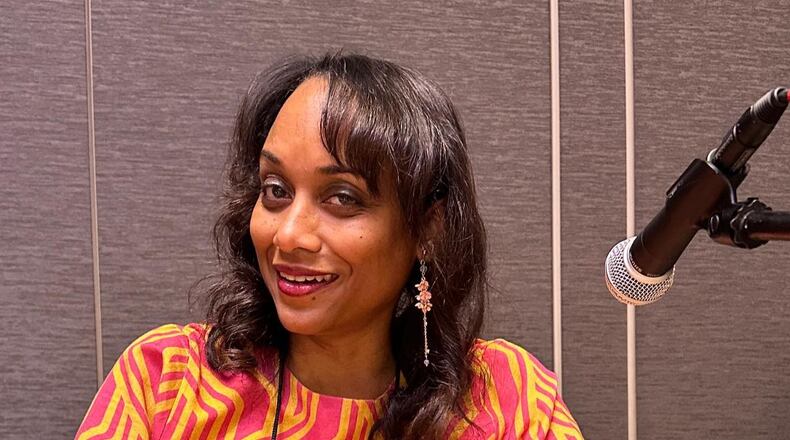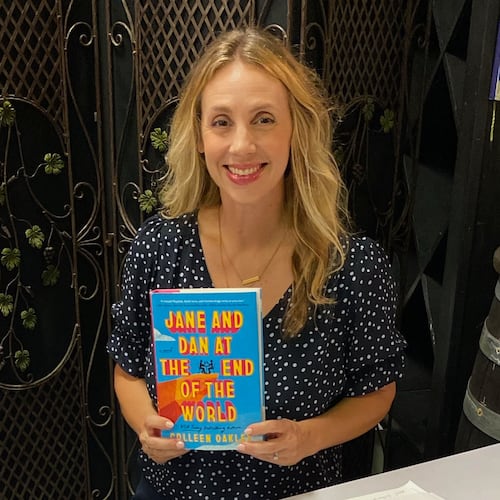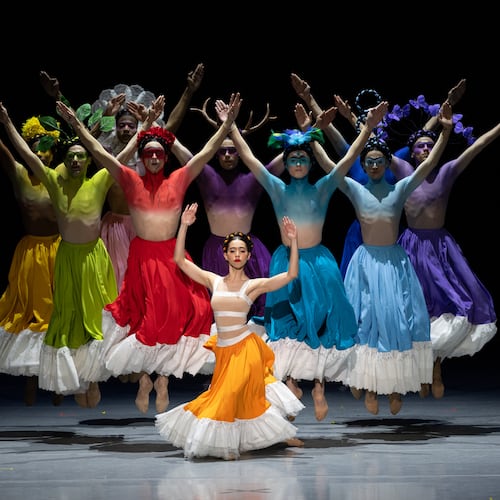This story was originally published by ArtsATL.
New York Times bestselling author Vanessa Riley digs deep for her stories.
Riley considers herself a detective in that way, mining research databases, combing through historical tomes, scouring old newspapers to excavate the lives of the Black women that history has left behind. She collects period fabrics, glistening taffetas that she can watch shimmer in the light, and burns period-specific candles — scents like evergreen — as she writes to help render old worlds new again.
The results are cinematic novels — historical fiction, romance and mystery — that bring back to life towering figures such as Gran Toya, a West African-born woman and warrior who helped drive the French out of Haiti.
In her most recent novel, “Queen of Exiles,” Riley introduces readers to Queen Marie-Louise Christophe, who alongside her husband, Henry I of Hayti (now Haiti), reigned over the first free Black nation in the Western Hemisphere. After their kingdom was overthrown, the queen fled with her daughters to Europe, where she established herself and her family as royalty in an elite, white, male-dominated world.
Riley, whose 2022 novel about Gran Toya, “Sister Mother Warrior,” in June earned her the 2023 Georgia Author of the Year Award for Literary Fiction, spoke with ArtsATL about growing up with stories, re-creating lost worlds on the page and uncovering the buried and beautiful histories of exceptional women.
Credit: Courtesy of Vanessa Riley
Credit: Courtesy of Vanessa Riley
Q: Can you tell us a bit about your own personal history with books and stories? Were you a big reader as a child?
A: I was a very big reader, and I had the best of both worlds. My mother loved literature, so she made sure she indoctrinated us with Shakespeare, Thoreau and Baldwin.
My father was from Trinidad and Tobago, and he was this wonderful storyteller. He had rhythm in the way that he told stories. And he would tell us these exciting things that would happen in the Caribbean. Because I’m the only girl, I usually had one story in there that was just for me. So I grew up in story.
As a high schooler, I was always journaling, writing little short stories, but I was also very good at math. My mom sat me down one day and she was like, “You always need to be able to pay your bills.” Having a full-time career (in writing) is like lightning striking, and if you look like me, with my background, you need a hurricane. So I went the math route. I had a fun time with the math route, and it does definitely pay the bills.
Q: Right. You’re the author of over 20 books now, but you did start in the STEM field (science, technology, engineering and math). You have a doctorate and two master’s degrees in engineering from Stanford. What did that shift look like, going from engineering to being a full-time author? What was so alluring about writing that it took you away from that field?
A: For a long time, I wrote technical papers, and I can distinctly remember one boss saying, “Oh, this report’s a little too interesting.” So writing was always a thing.
I had a difficult pregnancy, though, and I had to sit down. My doctor said, “You can’t do anything for four months.” And I said, “OK. Type-A person and you’re telling me I can’t do anything for four months? Are you insane?”
Credit: Courtesy of William Morrow
Credit: Courtesy of William Morrow
So my husband went up to the attic, and he pulled out a box of some of my early journals. I’m looking at these, and I see a story that I’d written in high school and I thought, “I can do that better now. I know more.” No, I did not know more, but I tried hard, and I just fell in love with writing again.
For a long time — I’ve only been full-time writing for two years — I had four jobs. I was in engineering during the day. I was a wife at a certain point and mommy, and then 10 p.m. to 2 a.m. was my writing time.
Q: Did you find that any of the skills from engineering transferred to your writing?
A: Oh, definitely. Engineering taught me the value of asking how and why. How does something work? Why was it built that way? I bring that to my writing. I go very deep in my research because I need to answer those questions. Why would a woman leave her home country, go to some place totally different? Why is this? How did she think she would manage?
Also, the ability to research. You give me a database, and I’ll make that thing sing. I love my engineering because it gives me that mindset. It also makes me a timeline stickler. When I find out what is happening in the world I’m writing about, or the character’s lives, I won’t shift a date for convenience or the story’s sake.
So you get both the rigor from engineering, plus that depth of asking those two valuable questions, and the wordsmith weaves it all together to make it engaging, make it something that captures your attention.
Credit: Courtesy of Vanessa Riley
Credit: Courtesy of Vanessa Riley
Q: I read an article where you talked about how you become a detective when you write a book. Can you tell us a little bit more about that?
A: You find a life. For “Sister Mother Warrior,” I found Gran Toya. Gran Toya was a Dahomey warrior who literally taught Jean-Jacques Dessalines how to fight, how to move troops, how to position his troops based on the stars. This is all from her African heritage of being a warrior in the Dahomey kingdom.
But when I found her, she was in a comic. She was in one page of a graphic novel, a graphic comic book. And you just get the feeling sometimes, like, “This is not a made-up character. Let me go do some research.” And then you start digging and digging. One question leads to another. How did this person become a Dahomey warrior?
Then the engineering mind kicks in. Her given name is actually Adbaraya Toya, so, what does that mean? It means “separated by water.” It’s got Yoruba roots, so she was probably in one of the nomadic villages the Dahomey took over. That’s all from asking that one little question.
So constantly you’re a detective. And sometimes, you have to disbelieve the narrative. Because people write with agendas in mind. I mean, I write with an agenda in mind. Mine is to bring these women back, to water the roots, to show the strength and the character of the people who are displaced in time or who have done something phenomenal that’s not expected of them. I love that.
But oftentimes, you’ll read these 200- or 300-year-old books that didn’t value women, didn’t value Black women. For (my book) “Island Queen,” there was one (reference book) trying to describe Dorothy’s first two children that she bore to her half-brother, the son of her “massa,” as the result of a relationship. I threw that 200-year-old book across the room because there’s no agency in enslavement.
Credit: Courtesy of Vanessa Riley
Credit: Courtesy of Vanessa Riley
Q: Right. Sometimes it’s a matter of asking, “What if this dominant narrative is not true?”
A: Exactly. What if the (dominant) narrative’s lying to you to cover up something else, and the author didn’t want to get into all of the things that these histories involve, and so they tried to package it up really nicely?
You have to analyze things. So, yeah, I’m a detective all the time, finding the right story, finding where these characters are. Where did they go? Who helped them on these journeys? Trying to find that, trying to build that, you become a detective every time.
Q: For your new book, “Queen of Exiles,” you have Haitian Queen Marie-Louise Christophe, who fled a coup in Haiti and went to Europe to build a new life, build her own royal court. How did her story find you? What was it about her life that most compelled you?
A: She was a minor character. Thomas Madiou is a historian who wrote about the Haitian Revolution 10 years after the revolution. So he was able to actually interview Marie-Claire and some of the principles. It’s a nice, thick four volumes in French.
As I’m translating these, I found little snippets of really cool things, but one of the people I found was the wife of Henri Christophe, Jean-Jacques Dessalines’ No. 2 man, Marie-Louise. Just one or two sentences. She seemed to be very unassuming in those sentences. But once again, that could’ve been the perspective of Madiou.
Then, I don’t know if I was reading some British newspapers or what, but (I saw) that they started putting plaques in London, these blue circle heritage plaques. They put one up very close to Mayfair, saying Madame Christophe and her daughters lived there. Then a few weeks later, another showed up in Hastings.
Credit: Courtesy of Vanessa Riley
Credit: Courtesy of Vanessa Riley
Modern historians have always talked about Marie-Louise, Queen Louise, as a sorrowful individual. They make it sound as if, when she got to England, that she was excluded from society because she was Black and poor. But if she’s poor, why is she living in Mayfair? I went to Hastings. I actually got to walk into her house. It’s gorgeous. You go into the sitting room that Marie-Louise had, and it looks out onto the Hastings Sea. This is top-tier real estate.
As I begin to dig, I find that she is also the first royal that I would say was media-stalked.
We see the Princess of Wales going different places, and we see this media frenzy. But I have found countless articles saying “Madame Christophe and her daughters going to Austria,” “Madame Christophe and her daughters going to Belgium,” “Madame Christophe and her daughters going to Florence, Rome.” They are listing her hotel. They are listing how many attendants she has with her. If there’s any gossip about the daughters, those are being put in the newspaper.
One of my favorite scenes that’s in the book is when, true story, there’s a big opera opening. All the royals have been invited. If you were ever a royal, you were invited to this big premiere. And they mention the front row, and it’s the ex-king of Westphalia, the ex-king of Holland, Madame Christophe and her daughters, the prince of Prussia. They’re seating them in order of precedence.
If she was excluded, she wouldn’t have been invited. If she was poor, she wouldn’t have been invited. Royals understand royalty. She and her daughters are members of this club. They are living as queen and two princesses in Europe. It’s a story that defies modern conventions.
Q: You’ve previously written about Gran Toya, and in “Island Queen,” we learn about Dorothy “Doll” Kirwan Thomas, who was born into slavery and went on to become the wealthiest woman landowner in the Caribbean. How do you choose which women you want to bring to life? What are the characteristics you’re looking for in your main characters?
A: I’m looking for the power women. The women who have done something completely unexpected for our gender, unexpected for our race. I want to blow away these preconceived narratives. Women are put into this little box. I want all the women that got out of the box and had fabulous lives.
The enslavement narrative is an important narrative. It focuses and grounds the struggles of the race. But it’s not the only story. Sometimes, those stories are tangential. Queen Louise was never enslaved. Her husband was, and it’s a tangential piece. But I love her journey, and what happened to her. How she thrived beyond the hurtful things, beyond the things that might’ve driven others into the ground. She kept going.
I want the narrative to reflect the resilience of this woman. You don’t know how many articles I’ve seen saying “sorrowful queen” (about her). Yes, she had sorrows, but she also went to spa resorts, operas. I want to see more of that. Because it makes you realize that no matter how bad things may be, there’s peace on the other side. There’s joy that comes in the morning.
So I look for people who I see have gone forward.
Q: Early in “Queen of Exiles,” the Queen and her youngest daughter are standing and looking at artwork. Queen Marie-Louise asks her daughter as they’re looking, “What of the future? Art should be about that, not just about the past.” What do you think stories about the past, about women like this queen, can teach us about the present and the future?
A: I think they can teach us that it’s OK to stand up for your beliefs. That it’s OK to be as feminine as one wants to be and still have power. It’s about understanding that we all have power. It might not look like somebody’s else’s power, but we all have power. To say no. To go different places. To do different things.
And lastly, the only thing to be afraid of is not trying. When (Queen Louise and her daughters) went to Europe, that was a gamble. They knew they weren’t safe, but at the moment in time they left, they were in a status. They weren’t being tormented. So one could’ve made an argument for them to stay.
But she made sure they moved forward. She kept moving forward. I think that’s really key.
::
Beth Ward is an Atlanta-based writer and editor. Her work has appeared in numerous publications, including The Rumpus, Hyperallergic, Atlas Obscura, BUST magazine, The Bitter Southerner, Atlanta magazine and Burnaway. Learn more about her work at bethwardwriting.com.
Credit: ArtsATL
Credit: ArtsATL
MEET OUR PARTNER
ArtsATL (www.artsatl.org), is a nonprofit organization that plays a critical role in educating and informing audiences about metro Atlanta’s arts and culture. Founded in 2009, ArtsATL’s goal is to help build a sustainable arts community contributing to the economic and cultural health of the city.If you have any questions about this partnership or others, please contact Senior Manager of Partnerships Nicole Williams at nicole.williams@ajc.com.
About the Author
Keep Reading
The Latest
Featured









